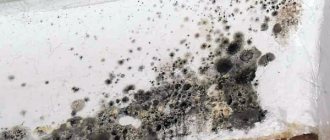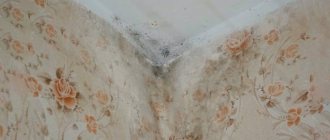Most amateur gardeners periodically encounter such a problem as white mold on the ground in flower pots. Beginners are especially upset, but they understand the reasons: they seem to have bought a good soil mixture in the store, bought large beautiful pots, and chosen a plant for a treat - some expensive orchid. Mold in a flower pot, how to get rid of it? And so, after some time, the soil became covered with threads with a characteristic unpleasant odor. It seems that the soil has “deteriorated.”
A novice gardener has questions: “What did I do wrong? How to preserve a plant and not let it die? And most importantly: mold in a flower pot - how to get rid of it?
What is mold
We also know from a school biology course: mold is a fungus. Like every mushroom, it reproduces by spores. The smallest particles of mold are constantly present in the air of our apartments. Once the humidity rises, it becomes mold. Appears on the walls of damp rooms. Covers bread that is steaming in a plastic bag. And it covers the soil in a flower pot with a coating with a characteristic smell.
There are several types of fungus.
Black mold
Despite the name, it is not only black. Can cover walls, ceilings, and multiply on food. It's difficult to get rid of it. In the old days they said that if black mold had settled in a house, it was easier to burn the house down than to remove it . It is especially difficult for people suffering from allergies to be in the vicinity of these “dark spots”.
White mold
More common and less dangerous. Appears on the ground, on plants, and sometimes on food. Sometimes it can be confused with a coating of mineral salts appearing on the soil. The main difference is that soft “fluffy” mold literally melts if you stretch it with your fingers.
Blue fungi
The bluish-blue color is distinctive for the colony of these fungi. It poses a particular danger to wood, contributing to its rapid decay.
Actinomycetes
Another type of fungus that is dangerous for trees and wood products. You can get rid of it only with the help of special toxic substances.
Efflorescence
Occurs most often. A layer of mold glittering with tiny crystals. It can form not only on the surface, but also penetrate into the soil.
This is also interesting: How to deal with wireworms in potatoes?
Why is mold dangerous?
Mold is considered quite dangerous for the plant, therefore, it should not be allowed to actively fill the space in the pot, and here’s why:
- The plant is sick because mold blocks the access of nutrients to the stems, leaves and flowers.
- The access to oxygen to the root system is also blocked.
- Mold can cause various diseases.
- Since soil moisture is higher than normal, the roots of the plant may simply rot.
If you postpone the fight against the fungus for an indefinite time, the flower will simply die.
Under what conditions does mold form in a flower pot?
In order for mold to appear in flower pots, prerequisites are needed. So why is this happening? The best conditions for the rapid growth of fungi are humidity and cool indoor air:
- this happens in cold and rainy summers, especially if the window in the room is constantly open;
- if you live on the first floor, above the basement, and dampness penetrates into the apartment (in this case, mold will also appear on the walls, in the corners of the room);
- in autumn and spring, when there is no heating. The house is not hot, plants need moisture less and do not actively absorb it from the ground;
In addition, there are other reasons:
- by collecting soil for flowers yourself, you run the risk: the soil may be “contaminated” with fungi;
- you have chosen heavy, clayey soil in which moisture stagnates;
- There is no drainage layer at the bottom of the pot ;
- the holes for the exit of excess water from the pot are clogged.
One or two of these reasons are enough for mold spots to appear on the surface of the earth, and you smell the rot.
Man-made reasons
Topping the list of the most common mistakes is temperature violation. Each plant in most cases does not tolerate changes in humidity and temperature. That is why, when placing pots on window sills or near the door, you should not be surprised that mold will appear there after a while.
We recommend that you read
Balance is needed everywhere, so seedlings must be placed where the optimum temperature is. For example, a shelf or a special rack for seedlings is suitable for these purposes. The main thing is that it does not stand in the way of a draft.
Traces of white mold can appear as a result of increased levels of humidity in the room. In modern apartments you can often find devices that increase the level of air humidity
They must be used with great care. Even if the doctor recommended humidifying the air in the room, this does not mean that plants in pots will like this procedure
Even if a person does not use such devices, an unpleasant plant disease can still appear. It is found in houses with a high level of dampness, for example, if the apartment is located above the basement. Another reason will be dilapidated communications. If the work of the housing office leaves much to be desired, then floriculture should be postponed.
Improper watering and defects in the pot are one of the reasons that attention is paid to only at the last moment. For the normal functioning of seedlings, regular watering and constantly functioning drainage are necessary.
Due to blockage of the drainage channels or their small size, fluid stagnation occurs. From the moment such a defect is formed until traces of mold appear, about 2-4 days pass.
Failure to follow the watering schedule is a mistake made by novice gardeners. Due to biological reasons and their structure, any plant can absorb a strictly certain percentage of liquid. That is why, before starting breeding, you should very carefully study the recommendations regarding a particular plant. A gardener must remember that overwatering is dangerous in all respects. In the best case, traces of mold will appear on the flowerpots, and in the worst case, the plant will die due to rotting of the root system.
First aid measures
The first thing gardeners want to do when they discover mold in a pot is to immediately dig up the plant and replant it in new soil. You may have to do this, but try less drastic measures first. After all, replanting is always stressful for the plant.
- At first, you should avoid frequent watering. It is better to moisten the soil generously once than to do it a little every day.
- Move the pot to the brightest and driest place in the apartment and do not approach the flower with a watering can for several days. Let the soil dry thoroughly.
- Raise the pot and check that the drainage holes are not clogged. Clean them if necessary.
- Carefully remove the top layer of soil covered with a layer of mold. Loosen the surface. The moisture will stagnate less, penetrate easier and deeper into the soil.
- Add fresh soil. In some articles you will find advice to calcine the earth on fire. But many experienced gardeners reject this recommendation: after heating to high temperatures, the microflora needed by the plant will be killed in the soil. Instead, gardeners advise covering the soil in the flower pot with light mulch for a few centimeters. Let’s say we put scalded and then dried hay on it.
- In the future, the plants can be watered by adding potassium permanganate to the water - on the tip of a knife. The color of the water should be only slightly pink. An excessively strong solution of potassium permanganate can burn the roots of plants. This is an effective remedy. After treating the soil, the smell of mold will disappear quickly. This method will also get rid of threads of fungus in the ground.
This is also interesting: Mold stains on a baby stroller: what to do?
If you still need to replant indoor plants
If the above measures do not help, it is possible that the plant will need replanting.
Carefully dig the flower out of the ground. Treat the roots with a weak solution of potassium permanganate.
The soil affected by mold should be thrown away and the pot should be disinfected. If it is ceramic, you can keep it in the oven, or pour boiling water over it. Please note that plastic pots are difficult to disinfect, and there is a good chance that it will not be possible to completely remove fungal spores from them.
Place a few centimeters of drainage at the bottom of the pot - you can buy it in special stores such as Priroda. Drainage should be followed by soil, also purchased at the store (give preference to “light” soils, with a lot of peat).
After that, plant the plant.
And remember that from now on you will water it much less often than before.
Treatment and prevention
Like any living creature, a plant that finds itself in soil infected with a fungus may require treatment.
- From chemical agents, foundationazole is suitable. You can buy it in stores that sell gardening supplies. Instructions are included with the drug. Dissolve 2 grams of foundationazole in 1 liter of water, treat the soil, stem and leaves of the plant.
- Activated carbon is used by mixing it with soil.
- Wood ash is used.
- You can water the plants 1-2 times with water to which lemon juice or a bag of citric acid has been added.
- Folk remedies include the following: dig pieces of chopped garlic into the ground and change them from time to time.
To prevent mold from appearing in the future , follow these simple rules:
- When purchasing new pots, choose ceramic ones rather than plastic ones.
- The pot should not be too large for the plant.
- Flowers should be kept in dry rooms, drafts should be avoided.
- Water with settled water, from time to time you can add a few crystals of potassium permanganate or 1-2 tablespoons of lemon juice.
- It is advisable to buy soil in a store. Be sure to add drainage to the bottom of the pot.
- Buy tools to care for indoor plants. Periodically loosen the soil in the flower pot, making sure that the drainage holes do not become clogged.
- It is recommended to cover the surface of the earth with a layer of mulch.
Remember that mold can appear in a pot with any plant : be it a simple violet or a rare orchid. The main thing is to notice the problem in time, to prevent the fungi from spreading and penetrating deep into the soil. Therefore, if indoor floriculture is your hobby, it is better to buy the necessary preparations, the same foundationazole, in reserve. Forewarned is forearmed.
Why do flowers get moldy?
If you have indoor plants in your home or office, you've probably seen a whitish or yellowish coating on the ground or walls of pots and planters. Actually, this is how mold begins to develop - from a barely noticeable coating. Most often, those flowers that suffer from this insidious fungus are those that do not need intensive watering and cannot absorb large amounts of moisture at once. These are, for example, cacti, succulents (among them are aloe, spurge, “money tree” and the very popular “mother-in-law’s tongue”, or sansevieria), so-called “living stones”, as well as violets.
A flower pot affected by mold is a sad sight
There are not as many varieties of mold as there are plants, but several types can still be listed.
White mold. That same white coating, which can then grow into a fluffy blanket on the ground. This is one of the most common types of mold and almost the safest. At first, by the way, it can be confused with a mineral deposit on the soil, but it feels much softer and thinner to the touch.
White mold, once it appears in a pot, can destroy the plant itself.
- Blue mold. Bluish fungi most often affect wood - that is, indoor trees and decorative wood chips, which many people use to decorate flower pots and wooden flowerpots and plant tubs, are in danger.
- Black mold. The most dangerous type of mold, both for plants and humans, is black mold. It is difficult to notice on the ground, but much easier - on the tray of a pot or on a windowsill. At first glance, black mold can be confused with soil, but this similarity is apparent. Unlike soil, mold is not easy to clean off. If you wipe a contaminated surface, ingrained marks will probably remain there.
Black mold can also spread from the soil to the leaves of the plant.
Whatever the type of mold, all these types are related and the reasons for their appearance are similar.
Infected substrate. The simplest thing is that perhaps the soil in your pot was already affected by mold even before you put it there. If you dug it up in the yard, then this is not surprising. But if you bought land in a store, then this is a serious reason to think about the integrity of the manufacturer. Or about compliance with storage conditions at the point of sale. Excessive watering. As mentioned above, some plants don't need much moisture and you may just want to "flood" them. Flowers do not have time to absorb so much water, their lower leaves and roots begin to rot - all this, combined with high humidity, creates a breeding ground for fungus.
Wet air. If everything is fine with watering, the problem may be that the air in the room with flowers is too humid. This is justified for a greenhouse with tropical plants, but for most of our house flowers such conditions are not suitable - the plants will wither and mold will grow. Poor drainage. Another possible reason is an improperly arranged pot. It must have a drainage hole and a spacious tray for excess water. At the bottom it is worth creating a drainage layer of pebbles or expanded clay. The soil must be structured in a manner suitable for a particular plant - it is best to buy a special substrate formulated for different types of house flowers
Clay soils should be used especially carefully - they retain moisture greatly and can also contribute to the appearance of mold.
The soil in the box with seedlings is covered with mold
This is also interesting: How to clean black mold from a washing machine and eliminate the nasty smell?
Another problem that you may encounter in the spring is the appearance of mold in a box of seedlings.
Newly planted seeds want to be watered more often, in addition, many people put plastic bags over boxes with seedlings, or cover the boxes with glass to create a greenhouse effect.
As a result, young plants become sick. Moreover, such a trend is noted. Tomatoes and peppers that have already grown a little are not affected by mold. It is the seedlings that suffer, and they are the most difficult to help . The tiny plants have not yet been picked, they are located at a short distance from each other, their roots are thin as threads.
What can be done in this case
Amateur vegetable growers advise doing this. First of all, you need to dry the soil . Remove the plastic or glass from the box and place the seedlings on a windowsill illuminated by the sun. You just need to make sure that the soil does not dry out, otherwise the seedlings may die.
When the soil dries, you should sprinkle a small layer of ash on top . This must be done carefully, protecting the plants so that the ash does not stick to them. You can use a teaspoon or a brush.
Now you should water the seedlings less often . And when you replant it - into a larger box or to a permanent place in the garden, try not to use soil that has been affected by mold. To do this, shake each plant slightly so that the soil adhering to the roots crumbles.
Professionals warn: if you notice mold, you should not hesitate, the seedlings may die. The surface of the soil should be sprinkled with mulch regularly, every 2-3 weeks. It is best to use a mixture of charcoal and ash.
If you have been storing soil for seedlings since the fall, taking it from your garden or the nearest forest, such soil should be treated in advance by watering it abundantly with potassium permanganate and drying it. You can add river sand to the soil, as well as a mixture of humus and leaf soil.
- When watering seedlings, experts recommend using water obtained from melting snow. Or scoop it out of the aquarium.
- If the soil continues to develop white spots, replant the plants. If you use the same box, disinfect it first.
The problem of mold in pots requires serious attention. The question of how to get rid of this persistent fungus worries many. Remember that the appearance of mold does not mean that your favorite plant will die . The main thing is to immediately begin the fight against the insidious fungus.
Danger of molds
The development of mold fungi leads to the formation of soil compactions, loss of air exchange, and processing of plant roots into food for mycelium. Plants can resist for a long time, they get sick, their leaves turn yellow, but the end is always the same. In the confrontation, mold wins and the infected plant dies.
You can try to save the plant by cauterizing the affected area with potassium permanganate or pouring antiseptics into the soil, but the likelihood of victory in most cases is low. It is necessary to change the soil, change the pot, cut off the affected part of the plant and re-root.
Not all types of mold are harmless to humans. Particles of mycelium, fungal spores are a powerful allergen that can seriously affect health, weaken the immune system, provoke a chronic runny nose, bronchitis, and increase the tendency to colds.
Dandruff on the head and skin of a person is also caused by mold fungi. If mold is not combated with the most active and irreconcilable methods, mycoses are inevitable.
With reduced immunity, mold fungi can develop activity inside the body of humans and animals. Mold also successfully affects aquarium fish, reptiles and amphibians.











